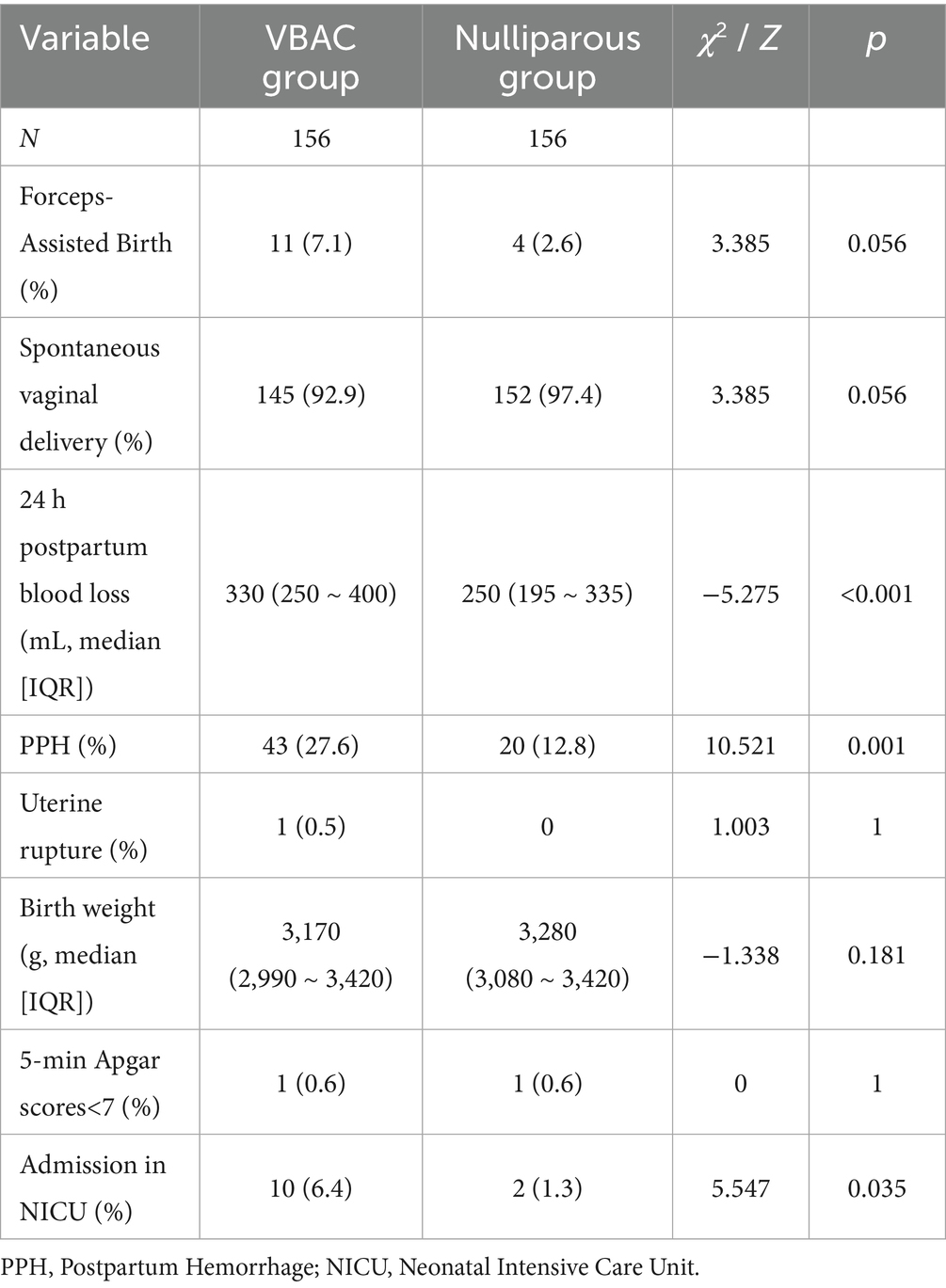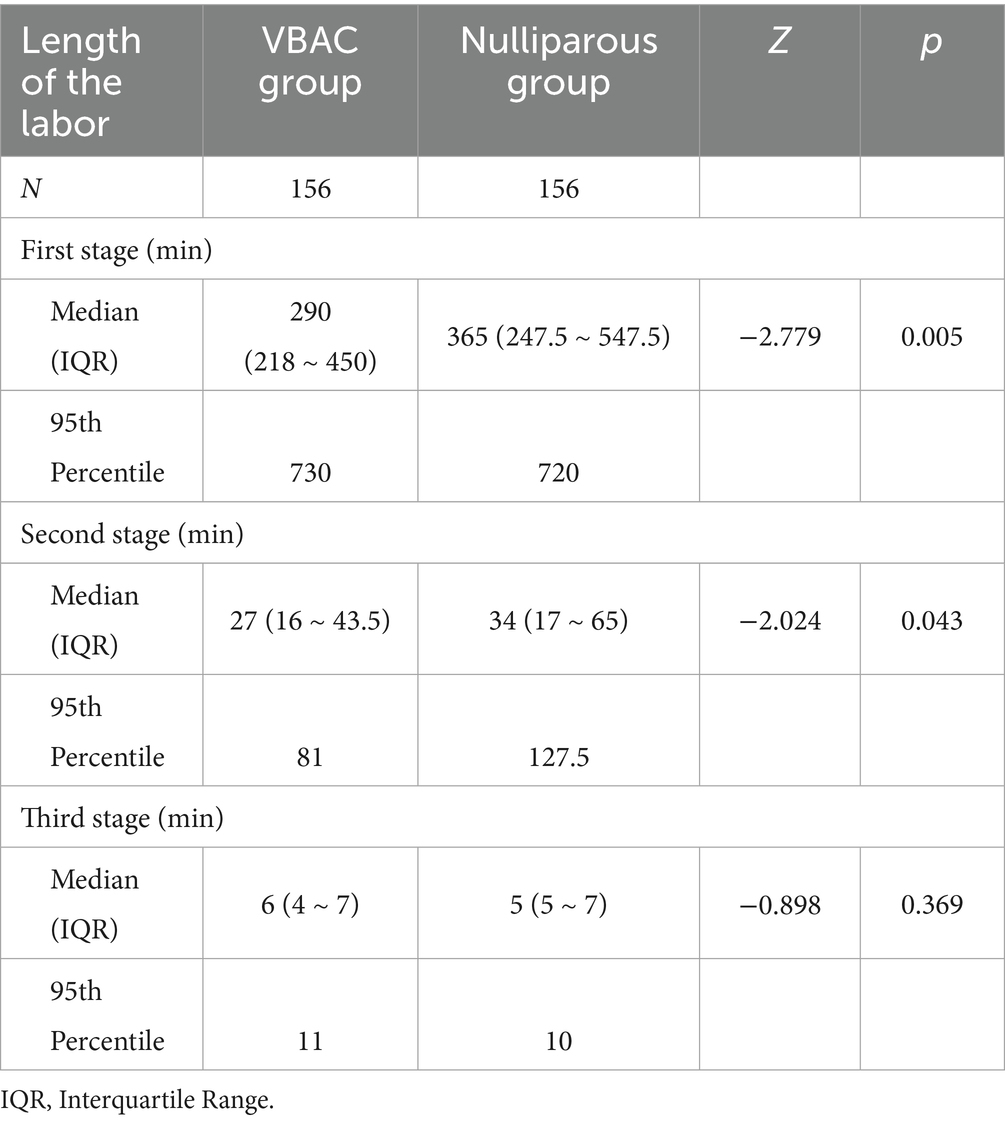- Chengdu Women’s and Children’s Central Hospital, School of Medicine, University of Electronic Science and Technology of China, Chengdu, China
Objective: This study aimed to characterize the labor duration distribution and evaluate maternal-neonatal outcomes of vaginal birth after cesarean (VBAC) under epidural anesthesia.
Method: In this retrospective comparative study, we analyzed 156 term singleton VBAC cases with epidural anesthesia at Chengdu Women’s and Children’s Central Hospital (January 2021–December 2024), matched 1:1 by age to nulliparous controls. Comparative analyses of baseline characteristics, pregnancy complications, delivery modes, pregnancy outcomes, and labor durations were performed using independent t-tests, Mann–Whitney U tests, and χ2/Fisher’s exact tests. VBAC cases were stratified by prior labor attempt (n = 25 with vs. n = 131 without) to assess its impact on labor progression, with Spearman tests evaluating inter-stage correlations.
Results: Demonstrated that VBAC cases had significantly higher median 24 h postpartum blood loss (330 vs. 250 mL), postpartum hemorrhage rates (43% vs. 20%), and neonatal NICU admission rates (10% vs. 2%) compared to nulliparous controls (all p < 0.05). The 95th percentile durations for VBAC were 730 min (first stage) and 81 min (second stage), both significantly shorter than controls (p < 0.05), while third-stage durations were comparable (95th percentile, 11 vs. 10 min, p > 0.05). Prior labor attempt did not influence VBAC labor progression (p > 0.05). Positive correlations existed between first and second stages in both groups (r = 0.297, p = 0.002).
Conclusion: These results suggest that VBAC under epidural anesthesia may progress faster through first and second stages of labor than nulliparous deliveries but carries higher risks of adverse outcomes. Clinical management should integrate multifactorial assessment, warranting further investigation into labor patterns and outcome relationships.
1 Introduction
The global cesarean delivery rate has risen steadily since the 1990s, becoming a major public health concern (1). China exemplifies this trend, with its national cesarean rate increasing from 41.6% in 2016 (2) to 44.5% in 2020 (3)—a surge attributable to evolving fertility policies and the growing proportion of advanced maternal age pregnancies. In this context of high cesarean rates coupled with the need for fertility preservation, optimizing delivery management for women with prior cesareans has emerged as a critical priority in perinatal medicine worldwide.
The concept of trial of labor after cesarean (TOLAC) was introduced in the United States during the 1970s to challenge the prevailing dogma of “once a cesarean, always a cesarean” (4). Promoted by the American College of Obstetricians and Gynecologists (ACOG) and the National Institutes of Health (NIH), TOLAC rates peaked at 28.9% in 1996. However, subsequent reports of uterine rupture cases led to stricter guidelines in 2010 for vaginal birth after cesarean (VBAC) (5). Current data indicates that approximately 21% of eligible women attempt TOLAC in the U.S., with a success rate of 85% (6, 7), underscoring the importance of meticulous labor management in achieving safe VBAC.
The progression of labor duration standards has provided an important reference for TOLAC management. In 1955, Friedman established the classic “S”-shaped labor curve based on data from 500 term deliveries, which guided clinical practice for half a century. His study defined the active phase as starting at 3 cm cervical dilation, with a recommended maximum second stage of 2 h for nulliparous women (8). However, in 2010, Zhang et al.’s large-scale study of 62,415 parturients challenged this standard. Their findings showed that labor progression was slower before 4–6 cm dilation, suggesting the active phase may actually begin at 6 cm. Additionally, they reported that the 95th percentile for the second stage was 3.6 h with epidural analgesia and 2.8 h without it for nulliparous women (9). These insights led to the 2012 revision of labor guidelines by Maternal-Fetal Medicine (SMFM) (10). Nevertheless, debates persist regarding whether prolonged labor increases risks such as postpartum hemorrhage and infection (11, 12). Moreover, there is limited evidence on whether these updated labor standards apply to TOLAC populations. Notably, current TOLAC labor studies primarily involve Western populations. Given China’s higher cesarean delivery rate, there is an urgent need to establish labor management strategies tailored to its unique demographic characteristics.
To address these critical evidence gaps, we conducted a systematic evaluation of VBAC cases at our tertiary referral center, analyzing both maternal-neonatal safety outcomes and labor progression patterns to inform evidence-based TOLAC management in high-cesarean-rate settings such as China.
2 Materials and methods
2.1 Study design and participants
This retrospective comparative study evaluated outcomes between two predefined groups: women with successful vaginal birth after cesarean (VBAC) and age-matched nulliparous women with spontaneous vaginal delivery at Chengdu Women’s and Children’s Central Hospital from January 1, 2021, to December 31, 2024. During the study period, a total of over 60,000 deliveries occurred. Inclusion Criteria: singleton pregnancy, term delivery (gestational age ≥37 weeks), cephalic presentation, no prior vaginal delivery and complete clinical records. Exclusion criteria included multiple gestation, preterm birth (<37 weeks), non-cephalic presentation, incomplete records, prior vaginal delivery, elective repeat cesarean (ERCD), or intrapartum cesarean during TOLAC. A total of 156 VBAC cases were included as the study group. To enable meaningful comparison, 156 term nulliparous women who achieved spontaneous vaginal delivery and met the same inclusion criteria of the study group during the same period were selected as controls (1:1 matching by maternal age ±2 years) (Figure 1).
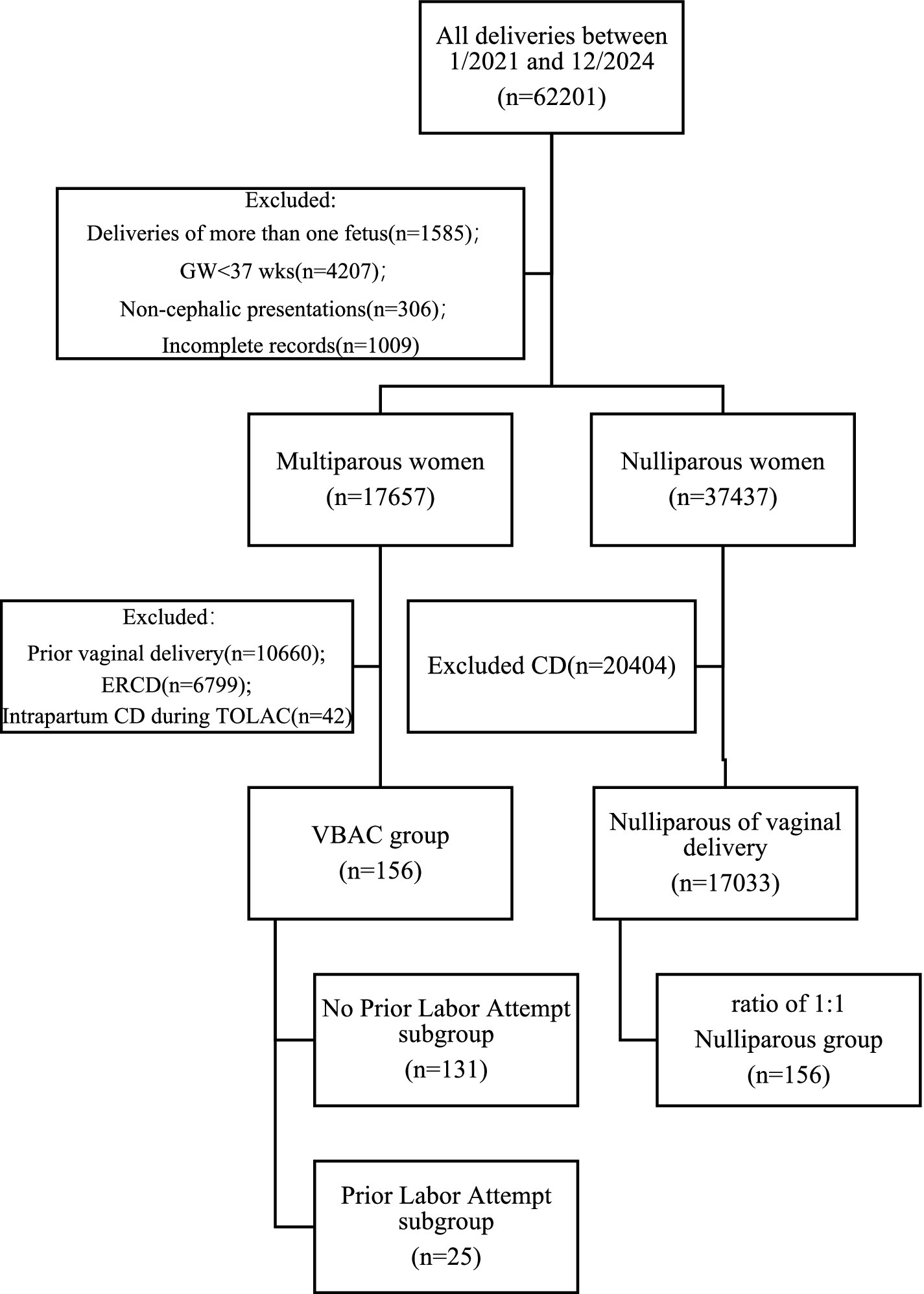
Figure 1. Study population enrollment flowchart. During the study period, a total of over 60,000 deliveries occurred. After screening based on the inclusion and exclusion criteria, a total of 156 VBAC cases were included as the study group, and 156 term nulliparous women delivering during the same period were selected as controls.
2.2 Management
2.2.1 Labor induction
Gestational age was confirmed by first-trimester ultrasound (8–12 weeks). Induction methods were determined by senior obstetricians based on Bishop score: for cases with Bishop score <6, cervical ripening was performed using a double-balloon catheter (DBC), followed by oxytocin induction if required; for cases with Bishop score ≥6, artificial rupture of membranes (AROM) and/or low-dose oxytocin infusion was administered.
2.2.2 Intrapartum management
All TOLAC patients received continuous fetal monitoring, intravenous access, and bedside electrocardiogram monitoring. Clear liquid intake was permitted, with urinary catheterization and routine blood tests (including blood type and screen) performed. The labor unit maintained 24/7 availability of attending obstetricians, anesthesiologists, and senior midwives, with immediate readiness for emergent cesarean delivery. For cases with inadequate contractions (defined as <3 contractions per 10 min, each lasting <45 s), labor augmentation was achieved through low-dose oxytocin infusion and/or AROM. Operative vaginal delivery (forceps-assisted) was utilized when indicated. Uterine integrity was assessed via pre-and postpartum ultrasound evaluation of the lower uterine segment.
2.3 Data collection
Maternal variables included: age (continuous, years); gestational age at delivery (weeks, confirmed by first-trimester ultrasound); pre-pregnancy BMI (kg/m2, categorized as <24 vs. ≥24 based on Chinese obesity criteria); gestational weight gain (kg, continuous); pregnancy complications (binary: present/absent for hypertensive disorders of pregnancy (HDP), diabetes, anemia, thyroid dysfunction); labor induction method (categorized as: double-balloon catheter, artificial rupture of membranes [AROM], oxytocin, or none); delivery mode (spontaneous vaginal vs. forceps-assisted); postpartum hemorrhage (PPH, defined as blood loss ≥500 mL within 24 h); and uterine rupture (clinical + ultrasound-confirmed). Neonatal variables included birth weight (grams), 5-min Apgar score (<7 vs. ≥7), and NICU admission (yes/no). Labor durations were recorded in minutes for first (onset of regular contractions to full dilation), second (full dilation to delivery), and third stages (delivery to placental expulsion).
All participants received standardized intrapartum care per institutional TOLAC protocol, including continuous fetal monitoring, readiness for emergent cesarean delivery, and postpartum uterine integrity assessment via ultrasound.
2.4 Group stratification
The primary analysis compared the VBAC group (n = 156) with age-matched nulliparous controls (n = 156). A secondary subgroup analysis was performed within the VBAC cohort, stratifying cases by indication for prior cesarean delivery: prior failed labor (n = 25) versus elective cesarean (n = 131). Labor duration distributions and inter-stage correlations were evaluated across all groups.
2.5 Statistical analysis
Statistical analyses were conducted using SPSS version 22.0. Normally distributed continuous variables were expressed as mean ± standard deviation and compared using independent t-tests. Non-normally distributed data were presented as median (interquartile range) and analyzed with Mann–Whitney U tests. Categorical variables were reported as frequencies (percentages) and compared using χ2 or Fisher’s exact tests, as appropriate. Correlations between labor stages were assessed using Pearson’s test. A two-tailed p-value <0.05 was considered statistically significant.
3 Results
During the study period, there were 7,099 pregnancies with a history of cesarean section, among which 198 cases (2.79%) underwent TOLAC. A total of 156 cases achieved VBAC, yielding a success rate of 78.79%. Uterine rupture occurred in 1 case (0.5%).
3.1 General characteristics and outcomes
Compared to the nulliparous group, the VBAC group demonstrated significantly higher gestational age at delivery and higher proportion of deliveries ≥40 weeks, but lower gestational weight gain (p < 0.05 for all comparisons). Regarding pregnancy complications, the VBAC group had higher incidence of diabetes but lower incidence of anemia compared to nulliparous women (p < 0.05 for both comparisons). In terms of labor induction methods, the VBAC group showed higher utilization rate of artificial rupture of membranes (p < 0.05) (Table 1).
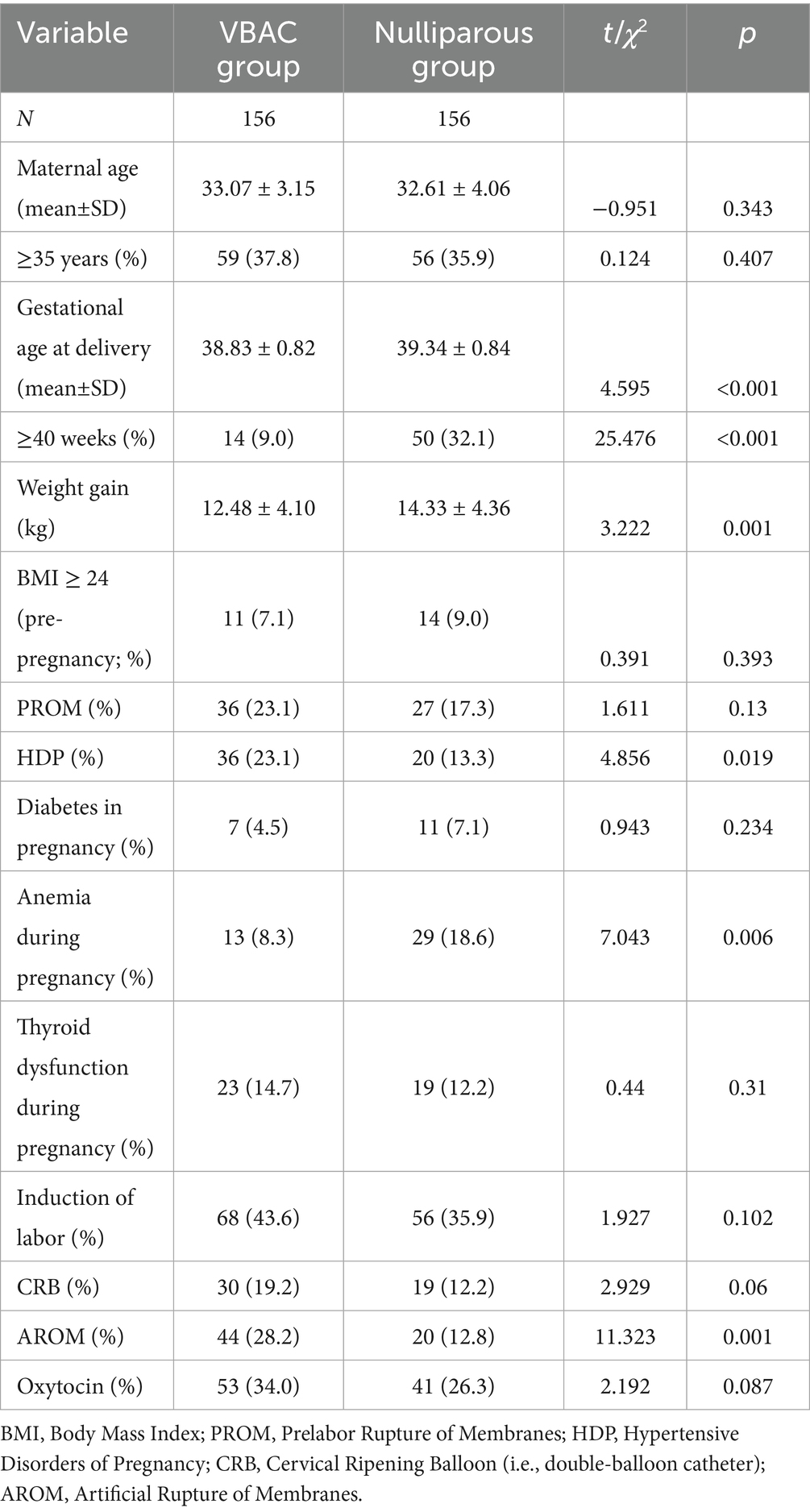
Table 1. Comparative analysis of baseline characteristics, pregnancy complications, and labor induction methods between VBAC and nulliparous groups.
For maternal outcomes, the VBAC group exhibited significantly greater postpartum blood loss and higher risk of postpartum hemorrhage. Neonatal outcomes revealed higher NICU admission rates in the VBAC group compared to nulliparous controls (p < 0.05 for all comparisons) (Table 2).
3.2 Labor duration distribution and correlation analysis
Both first and second stages of labor were significantly shorter in the VBAC group compared to nulliparous women with epidural anesthesia (p < 0.05). The median (Interquartile Range, IQR) first stage duration was 290 (218–450) minutes in VBAC group (95th percentile, 730 min) versus 365 (247.5–547.5) minutes (95th percentile, 720 min) in nulliparous group. For the second stage, VBAC group showed median duration of 27 (16–43.5) minutes (95th percentile, 81 min) compared to 34 (17–65) minutes (95th percentile, 127.5 min) in nulliparous group. Third stage durations were comparable between groups (Table 3).
To evaluate potential confounding from prior labor experience, we stratified VBAC cases into subgroups with (n = 25) and without (n = 131) history of labor attempt. No significant differences in labor durations were observed between these subgroups. The 95th percentiles for first, second and third stages were 757 vs. 742 min, 75.2 vs. 83.2 min, and 10.8 vs. 11 min in subgroups with and without prior labor experience, respectively (Table 4).
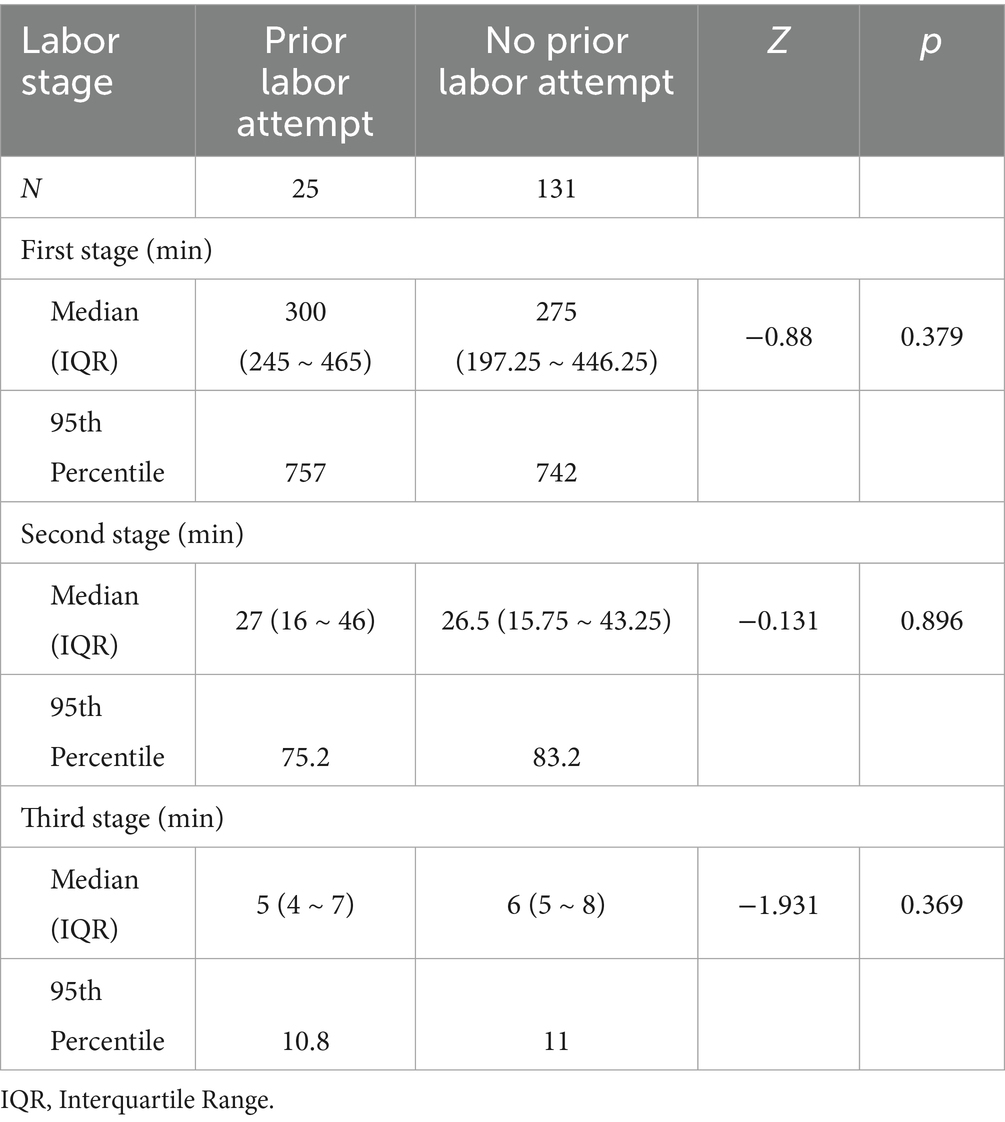
Table 4. Comparison of labor stage durations between VBAC subgroups with and without prior labor attempt.
3.3 Correlation analysis of labor stages
In VBAC group, significant correlation was observed between first and second stages (r = 0.297, p = 0.002), while no significant correlations existed between second and third stages (r = 0.097, p = 0.315) or first and third stages (r = 0.002, p = 0.672). Similarly, nulliparous group showed correlation between first and second stages (r = 0.232, p = 0.015) but not between other stage combinations (first-third: r = 0.027, p = 0.777; second-third: r = −0.099, p = 0.305).
4 Discussion
4.1 Antenatal management of VBAC
Current evidence indicates that the success rate of TOLAC in achieving VBAC ranges between 60 and 80% (13), with appropriate antenatal management being a crucial determinant of successful outcomes. Multiple studies have demonstrated that macrosomia (fetal weight ≥4,000 g) and maternal obesity (BMI ≥ 30 kg/m2) significantly reduce TOLAC success rates while increasing the risk of uterine rupture by 1.5- to 2-fold (14, 15). These associations may be closely related to gestational weight gain (GWG). The 1990 Institute of Medicine (IOM) report first systematically established the strong relationship between GWG and neonatal birth weight, showing that excessive GWG increases risks of macrosomia and dystocia, whereas overly restricted GWG may elevate risks of preterm birth and low birth weight (16). Consequently, researchers worldwide have explored various GWG management models, though no universal standard has been established due to variations in ethnicity, dietary culture, and socioeconomic status. The widely accepted approach involves individualized GWG targets based on pre-pregnancy BMI stratification (e.g., the 2009 IOM guidelines), although its applicability to TOLAC populations remains controversial. Our study found that the average GWG in the VBAC group (12.48 kg) was significantly lower than in nulliparous women (14.33 kg, p < 0.05), contrasting with Li et al.’s findings (3), which reported no difference (both groups ~14 kg). Although our TOLAC success rate (76.22%) surpassed that of Li’s study (68%), regional dietary differences preclude definitive conclusions regarding stricter GWG control for TOLAC. Future multicenter studies are needed to investigate GWG thresholds affecting VBAC success across BMI categories and to develop ethnicity-specific GWG management models.
4.2 Maternal and neonatal outcomes of VBAC
TOLAC offers women with prior cesarean sections the option of vaginal delivery, avoiding the risks associated with repeat cesarean sections and reducing the likelihood of placenta accreta spectrum disorders in subsequent pregnancies. However, our study revealed that the VBAC group had significantly higher 24-h postpartum blood loss (p < 0.001), postpartum hemorrhage rates (27.6% vs. 12.8%), and neonatal NICU admission rates (6.4% vs. 1.3%) compared to nulliparous women (p < 0.05), consistent with findings from Li and Zhou et al. (3, 17). Li suggested that with increasing parity, uterine muscle tone decreases, thereby elevating the risk of postpartum hemorrhage (PPH) in the VBAC group (3). Supporting this, a retrospective cohort study by Chen et al. (18) in China demonstrated that women with a uterine scar are at significantly increased risk of PPH. This heightened susceptibility is likely attributable to structural and functional uterine impairment resulting from the prior cesarean section, including compromised myometrial contractility and defective placental site involution during the index pregnancy (18). Furthermore, our study observed higher rates of forceps-assisted delivery and AROM in the VBAC group compared to the control group. These interventions may contribute to increased birth trauma and infection risk, potentially explaining the elevated NICU admission rates among neonates in the VBAC cohort. One case of uterine rupture occurred during the study (incidence: 0.5%), presenting as sudden fetal heart rate deceleration during labor. The diagnosis was confirmed via ultrasound following forceps-assisted delivery, and immediate surgical repair was performed, resulting in favorable maternal and neonatal outcomes. This underscores two key ACOG recommendations (4): (1) TOLAC must be conducted in centers capable of emergency cesarean delivery, and (2) standardized emergency protocols are essential. Although our center maintained uterine rupture rates at the lower end of guideline-reported ranges (0.5–0.9%) through strict GWG control and prenatal ultrasound assessment of the lower uterine segment, clinicians must remain vigilant for the classic triad of “acute abdominal pain, abnormal fetal monitoring, and hematuria.” We propose risk-stratified management for TOLAC candidates: low-risk women (e.g., prior vaginal delivery, spontaneous labor onset) may undergo intensified labor monitoring, while high-risk women (e.g., induction, labor arrest) should provide informed consent for potential emergency surgery to balance VBAC benefits and perinatal safety.
4.3 Analysis of labor duration
Considerable controversy persists regarding labor duration in VBAC, with limited large-scale data available. Hila Shalev-Ram et al.’s Israeli study of 422 VBAC cases (19) reported that the partogram was similar to those of nulliparous vaginal deliveries without epidural analgesia, a finding echoed by Graseck et al.’s U.S. study of 140 VBAC cases (20). In contrast, Li et al.’s analysis of 359 VBAC cases from Hubei, China (3), demonstrated significantly shorter median first-stage duration in VBAC (390 min) versus nulliparous women (450 min), a result corroborated by our study even after excluding women with prior labor attempts. This divergence likely reflects population differences in labor progression, as Graseck’s cohort included parous women with vaginal delivery experience. Our findings, achieved through strict standardization of oxytocin administration and exclusion of women with prior labor attempts, align with Li’s data and imply unique VBAC labor characteristics in Asian women. Notably, our VBAC group exhibited shorter first-stage durations than previous studies, potentially attributable to stricter GWG management (resulting in lower birth weights) and higher rates of artificial rupture of membranes (28.2% vs. 12.8%). The latter accelerates labor by increasing prostaglandin synthesis through lysosomal release of phospholipase A2 from amniotic cells. This also reflects heightened clinical attention to TOLAC cases, indicating that intervention intensity significantly impacts labor duration. However, neither this study nor Li’s research included labor curve analysis. Future studies should incorporate the new labor standards to better characterize cervical dilation patterns in TOLAC.
Regarding the second stage, international evidence remains inconsistent. A multicenter randomized controlled trial of 790 TOLAC cases from Ireland, Italy, and Germany associated shorter labor durations with higher TOLAC success rates (21), a conclusion supported by Mark P et al. (22) and Gabriel Levi et al. (23), who further identified significantly increased risks of adverse outcomes when the second stage exceeded 3 h. Conversely, G. Gitas et al.’s German study of 1,546 VBAC cases (24) found no significant differences in second-stage duration or outcomes before and after implementing the new labor guidelines, questioning their utility in TOLAC management. Discrepancies also exist in comparisons between VBAC and nulliparous women: Hila Shalev-Ram et al. (19) reported significantly shorter second stages in VBAC without epidural analgesia (19 vs. 47 min, p = 0.023), but this difference disappeared with epidural use (81 vs. 111 min, p = 0.34), possibly due to analgesia-induced reductions in PGE2 levels. In contrast, Gabriel Levin et al.’s study of 1,310 VBAC cases (25) demonstrated consistently shorter second stages in VBAC regardless of analgesia (overall median: 88 vs. 103 min; with epidural: 105 vs. 118 min; without epidural: 28 vs. 44 min; all p < 0.01). Our findings similarly confirmed shorter second stages in VBAC. Hila Shalev-Ram (19) suggested that even when the previous delivery was by cesarean section, the functional capacity of the birth canal may have changed, resulting in a shorter second stage compared to nulliparous women. On the other hand, due to the risk of uterine rupture in TOLAC, healthcare providers often provide more intensive labor monitoring, which may lead to a shortened second stage. These differences indicate that when developing TOLAC labor management strategies, it is necessary to comprehensively consider influencing factors such as analgesia methods and the intensity of labor interventions.
In addition to investigating the durations of all three labor stages, this study also analyzed the correlations between them. The results demonstrated a significant correlation between the duration of the first stage and that of the second stage, further validating the finding that both the first and second stages were significantly shorter in the VBAC group compared to the nulliparous group. This observation suggests that in clinical practice, prolonged first-stage labor should alert clinicians to the possibility of subsequent second-stage prolongation, warranting enhanced maternal-fetal monitoring.
4.4 Limitations
Our study has several limitations. Firstly, our study is a retrospective design and may have potential biases (e.g., selection bias, unmeasured confounders), in our future research, we hope to conduct a prospective study to further verify our research results. Secondly, the study’s findings may lack generalizability due to its single-center setting and modest sample size. To address this limitation, future research could adopt a multi-center approach and include a more diverse population to enhance the external validity of the results. Additionally, conducting a meta-analysis of similar studies could provide a broader perspective and improve the generalizability of the findings.
5 Conclusion
TOLAC labor management presents unique challenges and requires healthcare institutions to have comprehensive emergency resources and multidisciplinary collaboration capabilities. This study confirmed that VBAC parturients exhibit significantly different labor characteristics compared to nulliparous women, manifesting as markedly shorter durations of both first and second stages. However, labor management should not focus solely on temporal parameters. Instead, a multidimensional evaluation system should be established, where clinicians conduct comprehensive and dynamic assessments of maternal-fetal status. Clinical decision-making must also integrate multiple factors, including fetal monitoring results, labor progression trends, and maternal general condition. Currently, there remains significant disagreement in the global evidence base regarding TOLAC labor management, with particularly scarce high-quality research data focusing on Asian populations. Therefore, large-scale, multicenter prospective studies are urgently needed to establish an evidence-based TOLAC labor evaluation system that can provide more precise guidance for clinical practice.
Data availability statement
The original contributions presented in the study are included in the article/supplementary material, further inquiries can be directed to the corresponding author.
Ethics statement
The studies involving humans were approved by the ethics committee of the Chengdu Women’s and Children’s Central Hospital. The studies were conducted in accordance with the local legislation and institutional requirements. Written informed consent for participation was not required from the participants or the participants’ legal guardians/next of kin in accordance with the national legislation and institutional requirements.
Author contributions
TZ: Writing – original draft, Data curation. DL: Writing – review & editing. YL: Writing – review & editing. LX: Writing – review & editing.
Funding
The author(s) declare that financial support was received for the research and/or publication of this article. Financial support of this work was provided by the National Natural Science Foundation of China, Grant/Award Number: 82201864; the Project of Chengdu Women and Children’s Central Hospital, Grant/ Award Number: YC2022003. The funding agencies did not have any role in the design of the study, collection, analysis, and interpretation of data, and in writing the manuscript.
Conflict of interest
The authors declare that the research was conducted in the absence of any commercial or financial relationships that could be construed as a potential conflict of interest.
Generative AI statement
The author(s) declare that no Gen AI was used in the creation of this manuscript.
Any alternative text (alt text) provided alongside figures in this article has been generated by Frontiers with the support of artificial intelligence and reasonable efforts have been made to ensure accuracy, including review by the authors wherever possible. If you identify any issues, please contact us.
Publisher’s note
All claims expressed in this article are solely those of the authors and do not necessarily represent those of their affiliated organizations, or those of the publisher, the editors and the reviewers. Any product that may be evaluated in this article, or claim that may be made by its manufacturer, is not guaranteed or endorsed by the publisher.
References
1. Zipori, Y, Grunwald, O, Ginsberg, Y, Beloosesky, R, and Weiner, Z. The impact of extending the second stage of labor to prevent primary cesarean delivery on maternal and neonatal outcomes. Am J Obstet Gynecol. (2019) 220:191.e1–7. doi: 10.1016/j.ajog.2018.10.028
2. Liang, J, Mu, Y, Li, X, Tang, W, Wang, Y, Liu, Z, et al. Relaxation of the one child policy and trends in caesarean section rates and birth outcomes in China between 2012 and 2016: observational study of nearly seven million health facility births. BMJ. (2018) 360:k817. doi: 10.1136/bmj.k817
3. Li, H, Yang, L, Peng, J, Cheng, W, Ma, H, Wu, S, et al. Duration time of labor progression for pregnant women of vaginal birth after cesarean in Hubei, China. Ir J Med Sci. (2024) 193:1351–8. doi: 10.1007/s11845-023-03600-6
4. ACOG. ACOG practice bulletin no. 205: vaginal birth after cesarean delivery. Obstet Gynecol. (2019) 133:e110–27. doi: 10.1097/AOG.0000000000003078
5. ACOG. ACOG practice bulletin no. 115: vaginal birth after previous cesarean delivery. Obstet Gynecol. (2010) 116:450–63. doi: 10.1097/AOG.0b013e3181eeb251
6. Uddin, SF, and Simon, AE. Rates and success rates of trial of labor after cesarean delivery in the United States, 1990-2009. Matern Child Health J. (2013) 17:1309–14. doi: 10.1007/s10995-012-1132-6
7. Metz, TD, Stoddard, GJ, Henry, E, Jackson, M, Holmgren, C, and Esplin, S. How do good candidates for trial of labor after cesarean (TOLAC) who undergo elective repeat cesarean differ from those who choose TOLAC? Am J Obstet Gynecol. (2013) 208:458.e1–6. doi: 10.1016/j.ajog.2013.02.011
8. Friedman, EA. Primigravid labor; a graphic statistical analysis. Obstet Gynecol. (1955) 6:567–89. doi: 10.1097/00006250-195512000-00001
9. Zhang, J, Landy, HJ, Ware Branch, D, Burkman, R, Haberman, S, Gregory, KD, et al. Contemporary patterns of spontaneous labor with normal neonatal outcomes. Obstet Gynecol. (2010) 116:1281–7. doi: 10.1097/AOG.0b013e3181fdef6e
10. Spong, CY, Berghella, V, Wenstrom, KD, Mercer, BM, and Saade, GR. Preventing the first cesarean delivery: summary of a joint Eunice Kennedy Shriver National Institute of Child Health and Human Development, Society for Maternal-Fetal Medicine, and American College of Obstetricians and Gynecologists workshop. Obstet Gynecol. (2012) 120:1181–93. doi: 10.1097/aog.0b013e3182704880
11. Niemczyk, NA, Ren, D, and Stapleton, SR. Associations between prolonged second stage of labor and maternal and neonatal outcomes in freestanding birth centers: a retrospective analysis. BMC Pregnancy Childbirth. (2022) 22:99. doi: 10.1186/s12884-022-04421-8
12. Laughon, SK, Berghella, V, Reddy, UM, Sundaram, R, Lu, Z, and Hoffman, MK. Neonatal and maternal outcomes with prolonged second stage of labor. Obstet Gynecol. (2014) 124:57–67. doi: 10.1097/AOG.0000000000000278
13. Macones, GA, Peipert, J, Nelson, DB, Odibo, A, Stevens, EJ, Stamilio, DM, et al. Maternal complications with vaginal birth after cesarean delivery: a multicenter study. Am J Obstet Gynecol. (2005) 193:1656–62. doi: 10.1016/j.ajog.2005.04.002
14. Zelop, CM, Shipp, TD, Repke, JT, Cohen, A, and Lieberman, E. Outcomes of trial of labor following previous cesarean delivery among women with fetuses weighing >4000 g. Am J Obstet Gynecol. (2001) 185:903–5. doi: 10.1067/mob.2001.117361
15. Carroll, CS Sr, Magann, EF, Chauhan, SP, Klauser, CK, and Morrison, JC. Vaginal birth after cesarean section versus elective repeat cesarean delivery: weight-based outcomes. Am J Obstet Gynecol. (2003) 188:1516–22. doi: 10.1067/mob.2003.472
16. Keppel, KG, and Taffel, SM. Pregnancy-related weight gain and retention: implications of the 1990 Institute of Medicine guidelines. Am J Public Health. (1993) 83:1100–3. doi: 10.2105/ajph.83.8.1100
17. Zhou, P, and Guo, X. Comparison of maternal and neonatal outcomes between vaginal birth after cesarean section and normal vaginal birth. J Matern Fetal Neonatal Med. (2024) 37:2399942. doi: 10.1080/14767058.2024.2399942
18. Chen, B, Zhang, L, Wang, D, Li, J, Hou, Y, Yang, T, et al. Nomogram to predict postpartum hemorrhage in cesarean delivery for women with scarred uterus: a retrospective cohort study in China. J Obstet Gynaecol Res. (2020) 46:1772–82. doi: 10.1111/jog.14354
19. Shalev-Ram, H, Miller, N, David, L, Issakov, G, Weinberger, H, and Biron-Shental, T. Spontaneous labor patterns among women attempting vaginal birth after cesarean delivery. J Matern Fetal Neonatal Med. (2022) 35:9325–30. doi: 10.1080/14767058.2022.2031964
20. Graseck, AS, Odibo, AO, Tuuli, M, Roehl, KA, Macones, GA, and Cahill, AG. Normal first stage of labor in women undergoing trial of labor after cesarean delivery. Obstet Gynecol. (2012) 119:732–6. doi: 10.1097/AOG.0b013e31824c096c
21. Grylka-Baeschlin, S, Clarke, M, Begley, C, Daly, D, Healy, P, Nicoletti, J, et al. Labour characteristics of women achieving successful vaginal birth after caesarean section in three European countries. Midwifery. (2019) 74:36–43. doi: 10.1016/j.midw.2019.03.013
22. Hehir, MP, Rouse, DJ, Miller, RS, Ananth, CV, Wright, JD, Siddiq, Z, et al. Second-stage duration and outcomes among women who labored after a prior cesarean delivery. Obstet Gynecol. (2018) 131:514–22. doi: 10.1097/AOG.0000000000002478
23. Levin, G, Tsur, A, Tenenbaum, L, Mor, N, Zamir, M, and Meyer, R. Second stage duration and delivery outcomes among women laboring after cesarean with no prior vaginal delivery. Birth. (2023) 50:838–46. doi: 10.1111/birt.12734
24. Gitas, G, Proppe, L, Ertan, AK, Baum, S, Rody, A, Kocaer, M, et al. Influence of the second stage of labor on maternal and neonatal outcomes in vaginal births after caesarean section: a multicenter study in Germany. BMC Pregnancy Childbirth. (2021) 21:356. doi: 10.1186/s12884-021-03817-2
Keywords: labor duration, vaginal birth after cesarean, pregnancy outcomes, postpartumhemorrhage, epidural anesthesia
Citation: Zhu T, Luo D, Li Y and Xiong L (2025) Duration of labor stages and pregnancy outcomes in vaginal birth after cesarean: a retrospective comparative analysis. Front. Med. 12:1643142. doi: 10.3389/fmed.2025.1643142
Edited by:
Angelo Montana, Marche Polytechnic University, ItalyReviewed by:
Guido Pelletti, University of Bologna, ItalyLuis Carlos Machado Junior, Department of Health, Brazil
Copyright © 2025 Zhu, Luo, Li and Xiong. This is an open-access article distributed under the terms of the Creative Commons Attribution License (CC BY). The use, distribution or reproduction in other forums is permitted, provided the original author(s) and the copyright owner(s) are credited and that the original publication in this journal is cited, in accordance with accepted academic practice. No use, distribution or reproduction is permitted which does not comply with these terms.
*Correspondence: Liling Xiong, MTAyOTc1MDE3N0BxcS5jb20=
 Tianying Zhu
Tianying Zhu Dan Luo
Dan Luo Liling Xiong
Liling Xiong